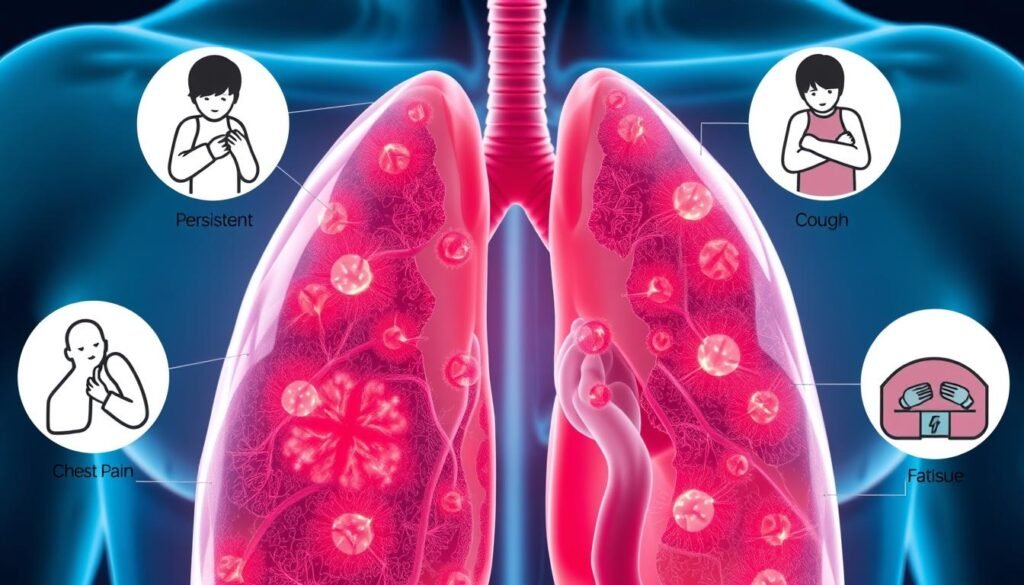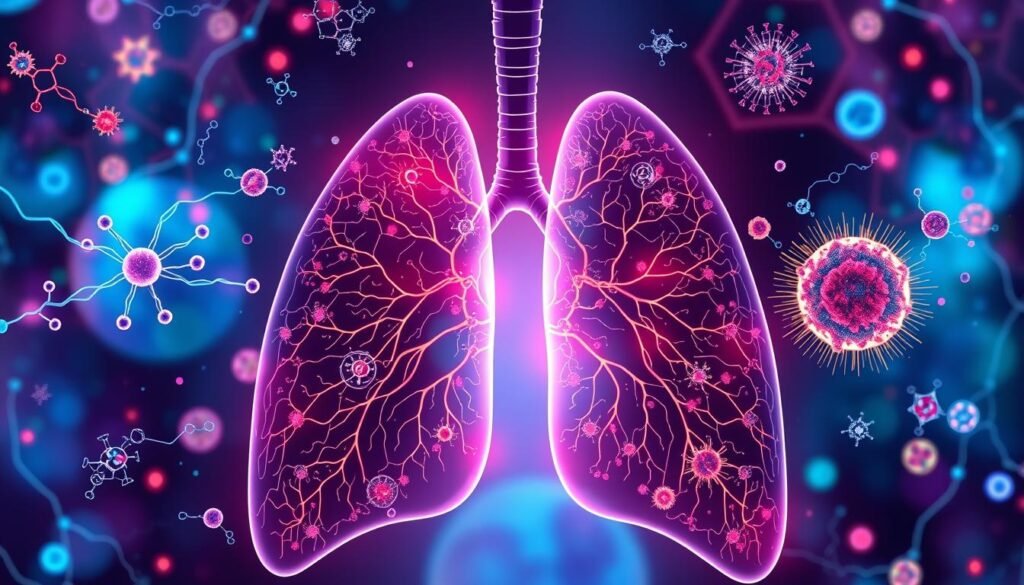About 10% to 20% of lung cancers, or 20,000 to 40,000 cases each year in the U.S., are in people who never smoked. This shows a big health issue called non smoking lung cancer. Knowing why it happens and the risks is key for teaching about lung cancer.
Non smoking lung cancer comes from things like genetic changes and the environment around us. It’s important we know how it affects non-smokers. Also, new genetic tests are changing how we treat it. It’s crucial to talk about this to improve public health.
We see that both things inside us and outside us can lead to lung cancer in non-smokers. By learning and sharing this info, we can better prevent lung cancer. Visit what causes lung cancer to learn about these factors.
Key Takeaways
- Non smoking lung cancer accounts for 10% to 20% of lung cancer cases annually.
- Genetic mutations and environmental factors are significant contributors to non smoking lung cancer.
- Awareness and education are vital for understanding risks related to lung cancer in non-smokers.
- Targeted therapies have become important in treating non smoking lung cancer patients.
- There are no standardized screening methods currently available for non-smokers at risk.
- Home radon tests are inexpensive, yet many homes still harbor dangerous levels of radon gas.
The Importance of Lung Cancer Awareness
Lung cancer is a leading cause of cancer deaths in the US. About 30% of cancer deaths come from lung cancer. Knowing symptoms and risk factors helps improve public health.
Non-smoking lung cancer grows quietly, often without symptoms. By the time symptoms show, the cancer is usually advanced.
Educating communities about lung cancer leads to better health choices. It’s crucial to avoid smoking and secondhand smoke. Early detection through screenings is key. It can find issues early, leading to better treatment success.
We need to spread the word about lung cancer’s effects, especially in non-smokers. It’s not just about awareness. We must also push for screening as advised by experts like the U.S. Preventive Services Task Force. Doing so can lower late-stage discovery and improve care for patients.
What is Non Smoking Lung Cancer?
Non smoking lung cancer occurs in folks who’ve never smoked or smoked very little (less than 100 cigarettes in their lifetime). This cancer is different from other types because it has unique features. Early detection and knowledge about it are crucial since 10% to 20% of lung cancers happen in non-smokers.
The main types of lung cancer in non-smokers are adenocarcinoma and squamous cell carcinoma. Adenocarcinoma makes up 50% to 60% of these cases. Squamous cell carcinoma accounts for 10% to 20%. Women and younger adults are more likely to get these types of lung cancer.
Researchers have found new subtypes of lung cancer in non-smokers. The “piano” subtype grows very slowly and has the least mutations. Another variant, “mezzo-forte,” grows faster and has unique chromosomal changes and EGFR gene mutations. The “forte” subtype, interestingly, shows patterns like those in smokers’ lung cancers.
Understanding non smoking lung cancer is critical. It includes knowing the types, the unique features, and why continued research is important. Raising awareness can help in diagnosing it earlier and finding better treatment ways.
| Subtype | Mutation Level | Growth Rate |
|---|---|---|
| Piano | Fewest mutations | Extremely slow |
| Mezzo-forte | Specific chromosomal changes | Faster than piano |
| Forte | Whole-genome doubling | Quick |
Statistics on Non Smoking Lung Cancer
Lung cancer not caused by smoking is a big problem in the United States. About 10% to 20% of these cancers happen to people who never smoked or hardly ever did. This means each year, 20,000 to 40,000 people get diagnosed. It’s important for everyone to know about this so they can be aware.
Secondhand smoke is dangerous too. It causes about 7,300 lung cancer cases in non-smokers every year. We need to work hard to lower the risks from smoking. Also, radon gas causes about 2,900 cases among non-smokers annually. This makes the situation more challenging.
Half of lung cancers in non-smokers are adenocarcinomas. Squamous cell carcinomas make up 10% to 20%. Small cell lung cancer is less common, making up 6% to 8%. What’s alarming is non-smokers often find out they have cancer at a late stage. We need to do more to prevent this from happening.
Causes of Lung Cancer in Non Smokers
Lung cancer isn’t just a smoker’s issue. It can happen in those who’ve never smoked. Environmental factors and harmful substances play big roles. Knowing these can help us be safer. Important factors are radon exposure, secondhand smoke, and polluted air.
Radon Exposure
Radon comes from the ground; it’s a radioactive gas. It can sneak into homes, a risk in some areas. It’s the second main cause of lung cancer for non-smokers in the U.S., taking about 2,900 lives yearly. Checking your home’s radon levels is a key step to take.
Secondhand Smoke
Secondhand smoke is a huge risk too. It’s linked to over 7,300 lung cancer deaths annually in the U.S. The risk is everywhere smoking happens. That’s why no-smoking rules in public places are crucial. Homes with smokers need to lower secondhand smoke to protect everyone.
Air Pollution
The air in cities can be dangerous too. Car exhaust and other pollutants are connected to lung cancer in non-smokers. Those living near busy roads must be careful. Fighting air pollution through policy changes can protect us and lower lung cancer risks.

Being aware of these issues can help prevent lung cancer. We need to stay informed and take steps to reduce our risk. For more info on preventing lung cancer, check out this resource.
Non Smoking Lung Cancer: Risk Factors
Looking into non smoking lung cancer, we focus on genetics and things around us. We must know these factors to boost awareness and encourage prevention.
Genetic Mutations
Research uncovers that 10% to 20% of lung cancers in non-smokers tie to genetic changes. Those who never smoked might have DNA variations leading to cancer. EGFR mutation is important here, influencing prognosis and treatment.
Knowing about these mutations helps create targeted treatments for patients.
Environmental Influences
External factors also up the risk of lung cancer in non-smokers. Things like air pollution, work-related dangers, and family history are key players. It seems women who’ve never smoked get lung cancer more often and younger than men who smoke.
Being aware of these dangers is the first step in health protection. Regular check-ups and alertness to symptoms are crucial for those at higher risk. For tips on early warning signs, check this source.
Common Symptoms of Lung Cancer
Knowing about lung cancer symptoms is key for getting help early. Catching it early can make treatment much more effective. Often, early signs can be missed because they seem like less serious issues. It’s important to know these signs for a timely medical check.
Early Symptoms
Lung cancer starts with mild symptoms that might not seem serious. These symptoms can be confused with other health problems. They include:
- Fatigue
- A persistent cough
- Unexplained weight loss
- Shortness of breath
- Hoarseness
- Loss of appetite
Since these signs can be vague, knowing them can help catch cancer early. If you notice these symptoms not going away, it’s wise to see a doctor.
Advanced Symptoms
As the disease gets worse, the symptoms will be more severe. Then, they start to really interfere with daily activities. The symptoms at this stage include:
- Chest pain
- Coughing up blood
- Wheezing
- Difficulty breathing
- Bone pain
- Swelling of lymph nodes
- Nervous system changes
- Yellowing of skin and eyes
- Swelling in the face, neck, or arms
Seeing a doctor is crucial if you notice any of these advanced signs. Immediate care can lead to better screening and help.

The Role of Genetics in Non Smoking Lung Cancer
Genetics is key in non-smoking lung cancer development. It’s essential to know the difference between inherited risks and cancer mutations. Individuals might inherit mutations that make them more prone to lung cancer. This includes changes in genes like TP53 and BRCA1. Such mutations can kickstart pathways important for tumor growth.
Somatic mutations, which appear after birth in the tumor, impact treatment and patient outcomes. Genetic variations, especially on chromosome 15 at the 15q24 spot, link to higher lung cancer risks in smokers and non-smokers alike. Research with over 35,000 people worldwide supports this connection. It suggests that some cancer mutations in non-smokers may come from healthy tissue, not just harmful exposure.
There are over 100 regions tied to complex diseases, showing genetics’ role in non-smoking lung cancer. Genome studies reveal that single nucleotide polymorphisms (SNPs) are common in lung cancer patients. This hints at a strong genetic and lung cancer risk link, affecting even non-smokers.
About 80% to 90% of lung cancers in non-smokers have mutations that can be treated. Knowing these genetic details helps in creating personalized treatments, increasing success chances for patients. Advances in genetic research promise better, customized therapies. More insights into this complex relationship can be found here.
Targeted Therapies and Treatments
Targeted therapies have changed how we treat lung cancer. They match treatments to specific mutations in tumors. This means doctors can use treatments that directly attack the cancer. This reduces damage to healthy cells.
Understanding Driver Mutations
Driver mutations lead to lung cancer in non-smokers. They are key to how tumors grow and decide the treatment. Tests for mutations like EGFR, ALK, and KRAS guide doctors in choosing the right therapy. Knowing these mutations allows for treatments designed just for them.
Testing for these genetic markers is crucial. Tests like next-generation sequencing (NGS) find many markers at once. This helps decide if targeted therapies are an option.
How we give targeted therapy varies. Some drugs are pills, while others are given through IV. For more severe cases, treatments like Avastin might be combined with other therapies. This shows how versatile these treatments are.
Compared to chemotherapy, targeted therapies often have fewer side effects. They mainly attack the cancer cells. This is better for patients’ quality of life. And with new research, lung cancer treatment keeps getting better.
| Driver Mutation | Prevalence in NSCLC | First-Line Targeted Therapy |
|---|---|---|
| EGFR | ~10-15% | EGFR inhibitors |
| ALK | ~5% | Crizotinib |
| ROS1 | 1-2% | Crizotinib |
| KRAS (G12C) | ~13% | Vemurafenib |
| BRAF V600E | ~1-3% | Dabrafenib |

Lung Cancer Prevention Strategies for Non Smokers
Lung cancer prevention for non-smokers has several key strategies. One important approach is testing the home for radon gas. This gas is a top cause of lung cancer for those who don’t smoke. About 26% of lung cancer deaths among non-smokers come from radon. Checking your home for radon, especially in areas known to have it, helps a lot.
Another vital step is supporting smoke-free areas. Secondhand smoke raises your lung cancer risk. Pushing for laws that ban smoking in public places can make our air cleaner. This protects everyone from the harms of smoking and secondhand smoke.
Living a healthy life also cuts down your lung cancer risk. Try to get at least 30 minutes of exercise like walking or cycling five days a week. Eating plenty of fruits, vegetables, and foods high in antioxidants helps too. These habits fight off not just lung cancer, but other illnesses as well.
Educating people and community outreach is crucial. These efforts teach about lung cancer in non-smokers and stress the need for early detection. They encourage everyone to live healthier, which can prevent lung cancer from happening.
| Prevention Strategy | Description |
|---|---|
| Radon Testing | Test homes for radon gas and take measures to reduce high levels. |
| Smoke-Free Spaces | Support laws that create smoke-free environments, reducing secondhand smoke exposure. |
| Healthy Lifestyle | Engage in regular physical activity and maintain a balanced diet rich in fruits and vegetables. |
| Education and Outreach | Participate in community programs that promote awareness and prevention of lung cancer. |
Living a Smoke-Free Lifestyle
Choosing a smoke-free life is key in fighting lung cancer, especially for those who never smoked. By taking steps to prevent lung cancer, we can greatly lower our risk. It’s crucial to make healthy choices for the sake of our lungs.
When communities create smoke-free zones, they boost public health. These areas not only offer clean air to breathe. They also show how important it is to avoid tobacco for lung health. Programs that teach about smoke’s dangers help people make smarter health decisions.
To encourage living without smoke, we can:
- Start support groups in the community for a healthier lifestyle.
- Begin health campaigns to stop smoking and highlight smoke-free benefits.
- Share facts about the risks of secondhand smoke, which kills thousands in the U.S. each year.
- Promote eating fruits and veggies to possibly reduce lung cancer risk.
Embracing a smoke-free life makes our lungs and communities healthier. It shows why choosing well at every chance is vital.
The Impact of Secondhand Smoke
Secondhand smoke is a major public health issue, leading to over 7,300 lung cancer deaths annually in the U.S. among non-smokers. It also adds to other health issues such as heart disease and stroke. Indeed, non-smokers exposed to it have a 25–30% increased risk of heart disease and a 20–30% higher risk of stroke.
For children, the dangers are even greater. They face a higher chance of respiratory diseases like asthma and ear infections. Also, infants exposed to secondhand smoke have a greater risk of sudden infant death syndrome (SIDS), the top cause of death in healthy infants. Reducing exposure to secondhand smoke is critical, especially for children’s health.
About 34,000 non-smokers die prematurely from heart disease each year due to secondhand smoke. This issue also brings a financial burden, with $7.2 billion in lost productivity costs in 2017. Raising awareness about these dangers is vital. Creating smoke-free spaces can make a big difference in public health and lower the risk of lung cancer.
| Health Issues Caused by Secondhand Smoke | Impact on Non-Smokers |
|---|---|
| Lung Cancer | Increases risk by 20-30% |
| Coronary Heart Disease | Increases risk by 25-30% |
| Stroke | Increases risk by 20-30% |
| SIDS in Infants | Higher likelihood of occurrence |
| Respiratory Diseases in Children | Higher risk of asthma and infections |
Conclusion
Understanding lung cancer in non-smokers is key to helping those at risk. Research shows that while most lung cancer deaths are linked to smoking, around 10-15% happen in people who never smoked. This fact calls for increased awareness, especially in those with a genetic risk or environmental exposure.
To prevent this type of lung cancer, making healthy lifestyle choices is important. This includes eating better, being more active, and avoiding carcinogens like second hand smoke and radon. Living a life without smoking can also lower lung cancer rates significantly.
Learning more about lung cancer in non-smokers is crucial in fighting this health issue. By focusing on education and prevention, we can make a difference. It’s vital to keep researching to safeguard at-risk individuals and improve lung health for everyone.